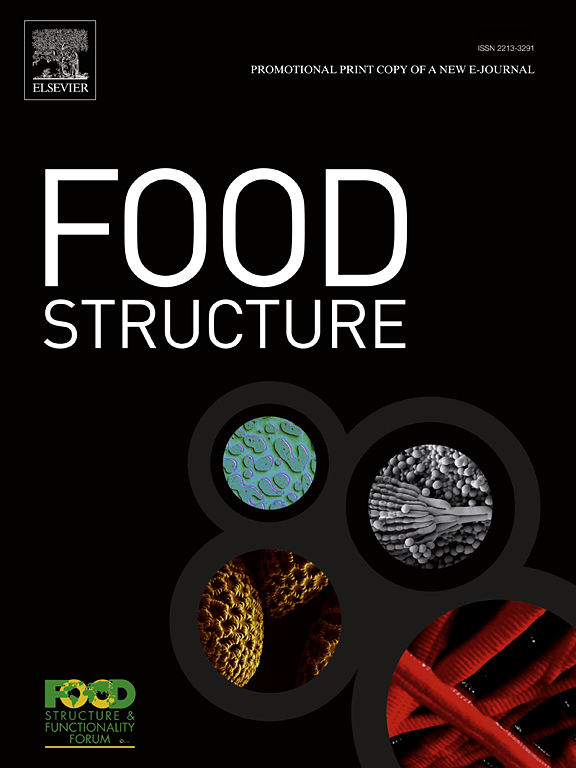以豌豆蛋白水解物为功能成分改善高蛋白酸奶替代品的质构
IF 5.9
3区 农林科学
Q1 FOOD SCIENCE & TECHNOLOGY
引用次数: 0
摘要
非乳制品酸奶替代品在市场上越来越受欢迎,但酶解对高蛋白质含量豌豆蛋白酸奶替代品(PBYA)的质地和结构特性的影响尚不清楚。在这项研究中,商业豌豆分离蛋白用胰蛋白酶水解,使用pH-stat方法,得到水解程度约为1 %。水解导致主要豌豆蛋白的显著降解,包括信服蛋白(~ 95-97 %)、vicilin(~ 88-93 %)和豆科蛋白α(~ 93-97 %)。以豌豆蛋白水解产物为原料,在实验和中试条件下制备了蛋白含量为10 % (w/w)的PBYA -PBYA,并与以豌豆分离蛋白为原料的对照PBYA (PPI-PBYA)进行了比较。PPH-PBYA比PPI-PBYA(~ 50-70 µm)具有更小的凝胶粒径(~ 20-40 µm),并且具有更柔软和光滑的质地。例如,与PPI相比,在中试规模生产的PPH-PBYA具有更低的屈服应力(~ 32 Pa vs. ~ 454 Pa),更低的流动一致性系数(~ 135 Pa)。sn vs. ~ 1016 Pa。sn)和较低的硬度(~ 3 N vs. ~ 9 N)。此外,水解处理对协同稳定性没有负面影响;PPI-和PPH-PBYA的特征合成率为<; 1 %。此外,PPH-PBYA在弹流润滑工况下的摩擦系数较低,表明其润滑性能优于PPI-PBYA。纹理和结构的改善与视觉和显微观察一致,PPH-PBYA具有更光滑的表面特征和更均匀的微观结构。豌豆蛋白酶解对PBYA颗粒大小、结构和微观结构的影响在中试规模试验中与在实验规模试验中表现出相似的趋势,验证了大规模生产的可行性。该研究为酶处理制备高蛋白质含量和优化结构性能的商用PBYA产品提供了一条可行的途径。本文章由计算机程序翻译,如有差异,请以英文原文为准。
Improving the texture and structure of high protein yogurt alternative using pea protein hydrolysate as a functional ingredient
Non-dairy yogurt alternatives have become increasingly popular in the market but the impact of enzymatic hydrolysis on the textural and structural properties of pea protein based yogurt alternative (PBYA) with high protein content is not well understood. In this study, commercial pea protein isolate was hydrolyzed with trypsin using the pH-stat method to obtain a degree of hydrolysis of approximately 1 %. The hydrolysis led to a significant degradation of the major pea proteins including convicilin (∼95–97 %), vicilin (∼88–93 %) and legumin α (∼93–97 %). The PBYA made from pea protein hydrolysate, namely, PPH-PBYA, was produced at both bench and pilot scale with a protein content at 10 % (w/w) and was compared with the control PBYA made from pea protein isolate (PPI-PBYA). The PPH-PBYA contained a smaller gel particle size (∼20–40 µm) than PPI-PBYA (∼50–70 µm), and possessed softer and smoother texture. For instance, the PPH-PBYA manufactured at pilot scale, when compared with the PPI counterpart, had lower yield stress (∼32 Pa vs. ∼454 Pa), a lower flow consistency coefficient (∼135 Pa.sn vs. ∼1016 Pa.sn), and lower firmness (∼3 N vs. ∼9 N). Moreover, the hydrolysis treatment did not negatively impact syneresis stability; the characterized syneresis rates for both PPI- and PPH-PBYA were < 1 %. Furthermore, PPH-PBYA exhibited lower frication coefficients at the elastohydrodynamic lubrication regime, suggesting a better lubrication behavior compared with PPI-PBYA. The improvement in the texture and structure was consistent with visual and microscopical observations, where the PPH-PBYA featured smoother surface characteristics and more homogenous microstructure. The impacts of enzymatic hydrolysis of pea protein on particle size, texture, and microstructure of the PBYA produced from pilot scale trials showed a similar trend to those produced from the bench scale, validating the feasibility for scale-up production. The study provides a feasible route to manufacture commercial PBYA products with high protein content and optimized textural properties using enzymatic treatment.
求助全文
通过发布文献求助,成功后即可免费获取论文全文。
去求助
来源期刊

Food Structure-Netherlands
Chemical Engineering-Bioengineering
CiteScore
7.20
自引率
0.00%
发文量
48
期刊介绍:
Food Structure is the premier international forum devoted to the publication of high-quality original research on food structure. The focus of this journal is on food structure in the context of its relationship with molecular composition, processing and macroscopic properties (e.g., shelf stability, sensory properties, etc.). Manuscripts that only report qualitative findings and micrographs and that lack sound hypothesis-driven, quantitative structure-function research are not accepted. Significance of the research findings for the food science community and/or industry must also be highlighted.
 求助内容:
求助内容: 应助结果提醒方式:
应助结果提醒方式:


